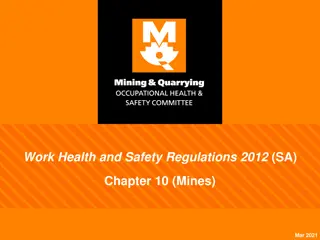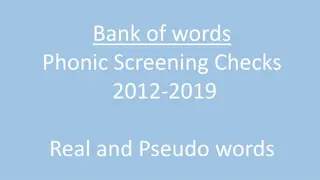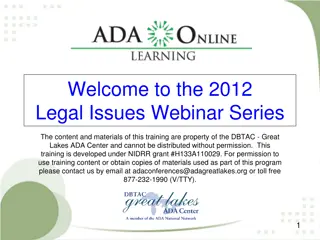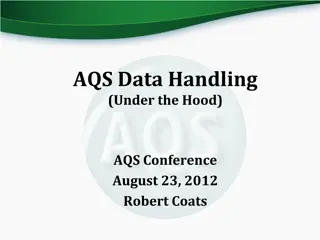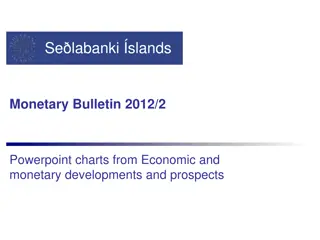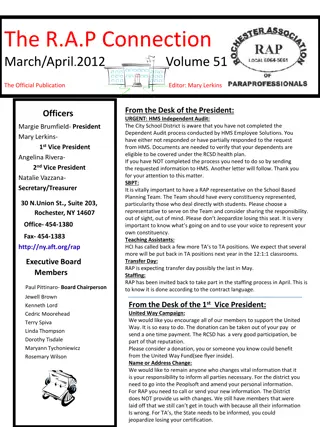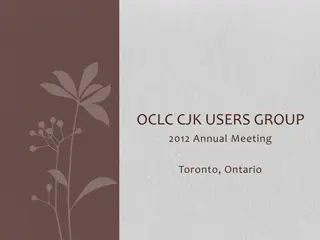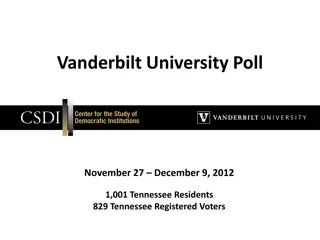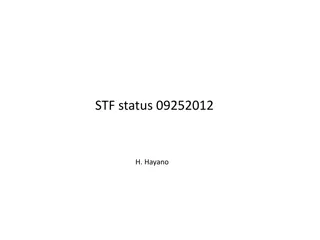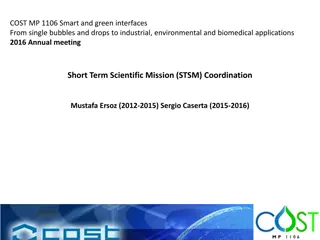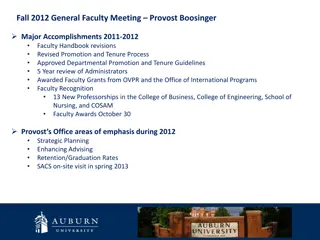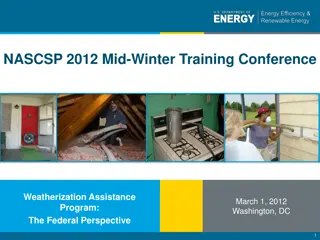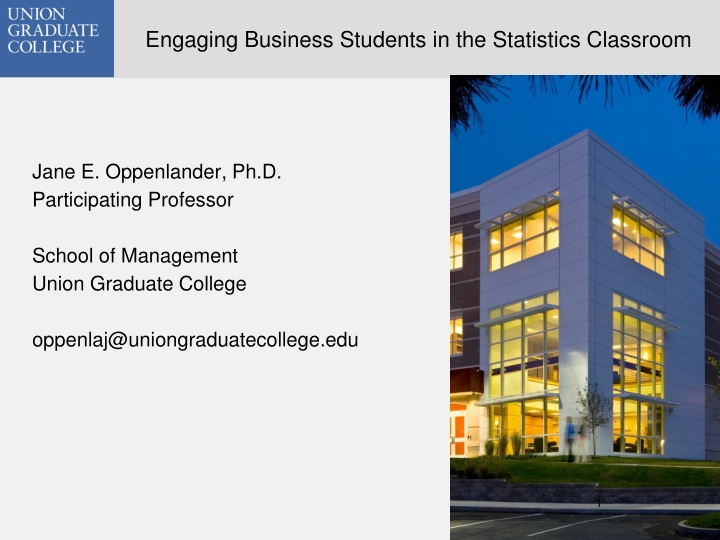
Engaging Business Students in Statistics Classroom with Practical Approach
Explore how to engage MBA students in statistical models for management through practical problem-solving, relevant data, and application to business decision-making. Overcome distractions and reluctance to learn statistical software through a hands-on, problem-oriented course approach focused on clear communication and analysis of statistical findings.
Download Presentation

Please find below an Image/Link to download the presentation.
The content on the website is provided AS IS for your information and personal use only. It may not be sold, licensed, or shared on other websites without obtaining consent from the author. If you encounter any issues during the download, it is possible that the publisher has removed the file from their server.
You are allowed to download the files provided on this website for personal or commercial use, subject to the condition that they are used lawfully. All files are the property of their respective owners.
The content on the website is provided AS IS for your information and personal use only. It may not be sold, licensed, or shared on other websites without obtaining consent from the author.
E N D
Presentation Transcript
Engaging Business Students in the Statistics Classroom Jane E. Oppenlander, Ph.D. Participating Professor School of Management Union Graduate College oppenlaj@uniongraduatecollege.edu 1
Statistical Models for Management Required course for MBA students Class meets for 11 weeks, once a week in the evening for 3 hours, 20 minutes Typical class sizes from 15-25 Pre-requisite Introduction to probability Taught in an electronic classroom (with WiFi); nearly all students bring laptops Student population: Full-time: 50% Part-time: 50% Average Age: 25 Motivation: Career change, job advancement, direct from undergraduate studies Diversity in undergraduate majors, prior exposure to statistics, work experience 2
Issues Observed with Modern Students Distractions In the classroom: Laptops, cellphones, WiFi Outside the classroom: Jobs, business trips, family, other courses Prior perception of the class (3.65/5 from course evaluations) Learning for the test Preference for the soft subjects in the business curriculum Reluctance to participate in class (grows as class size increases) Resistance to learning a statistical software package (JMP) Preference for on-line interactions 3
How We Engage Business Students Demonstrate the value of statistics to business decision-making Problem solving approach Relevant data and problems Interpret statistical concepts in the terms of business, e.g., standard deviation is a measure of risk Integrate to other courses in the MBA curriculum 4
Course Approach Problem-oriented Managers need to understand how to apply statistical methods to business problems and interpret results. Rely on statistical software (JMP) to perform calculations. Statistical concepts are presented in plain English or graphically. Use of formulas is minimized. Each method is illustrated by an example using the framework: Problem statement Data requirements Implementation in JMP Discussion of JMP results Interpretation of results to address the problem statement 5
Learning Objectives Effectively communicate the use of and results from statistical methods as applied to business problems and decision making. Focus on clear, concise writing and data presentation via technical reports, memos, and presentations. Synthesize numerical and graphical results of statistical analysis and communicate them in written reports. Identify problems and analyze data that require simple comparisons of means, two-sample, paired and ANOVA designs. Estimate and evaluate simple and multiple regression and time series models, especially for forecasting, to find important predictor variables to change or control a response variable. Identify problems and analyze data using measures of association to establish empirical cause and effect. 6
A Typical Class Review of previous week s assignment and study problems Introduction of methods and their use in a business setting Presentation of a detailed example illustrating a statistical method Problem is straightforward. Instructors walks the students through the problem formulation, data requirements, analysis in JMP, identification of key results from output. Brief class discussion of how the results are applied to the business problem. Small Group Exercise Problem may have a small complication (outlier, missing data, violation of assumption, unclear problem statement) Class discussion 7
Icebreakers for Motivating the Subject/Concept Hans Rosling svideo 200 countries, 200 years, 4 minutes Assignment on managerial responsibility Find an article pertaining to the role of mathematical models in the 2006 financial crisis. Write a paper summarizing the article and give lessons learned for managers. Classroom discussion of lessons learned Problem formulation What is a good apple? Model building Sketch possible relationships between sales and amount of advertising. 8
Classroom Activities Small group problem solving Role playing, manager and analyst Team modeling competition given a data set which team can find the best model. Review PowerPoint slides and memos that contain errors 9
A Taste of Reality Collect Your Own Data for Multiple Regression Learn the importance of having a range of independent variables Appreciate the importance of well-designed data collections Data sets with outliers or missing values Problems with insufficient information or vague problem statements Require students to make assumptions Recommend additional data/analysis needed to draw conclusions Research the topic Learn about the business context in order to solve the statistical problem Property tax assessment methods for a real estate problem Investment strategies for capital asset pricing model 10
Student Evaluation Papers 60%, Tests 40% One page business memo descriptive statistics for a data set Two case studies prepared in technical report format One-way ANOVA and multiple regression Capital asset pricing model analysis for a stock of their choice, summarized as a technical report Two tests short answer, emphasizing explanation and interpretation of statistical results Do not use statistical software for the test, output provided 11
Regression Case Studies Gender Discrimination Collinear variables Uses nominal variables Real Estate Pricing Students collect their own data Often encounter multicollinearity Learn the need to collect independent variables over a wide range of values ( (?? ?) 2 ) Challenger Disaster Making high consequence decisions from real data Incorporates audio and video Extrapolation, small sample size, low precision data, outliers 12
Sample Rubric Grading Criteria Weight (%) Introduction to business situation and clear problem statement 10 Statistical data summary 10 Correct analysis method applied, methods discussion - technical quality of multiple regression analysis equation, evaluation of model quality, VIFs, Std. Betas, and residuals 20 Interpretation of statistical results 25 25 Conclusions, recommendations, and discussion of results as applied to business situation Completeness and presentation quality - Appropriate amount of JMP output included with the text, all questions addressed, within page limit, writing quality including structure, organization, clear and concise writing, and correct grammar 10 13
Course Resources Textbook that integrates JMP software Supplemental material how to write and format a technical report, getting started with JMP, how to obtain data from yahoo finance. Sample tests with solutions Worked study problems for each method On-line reference gallery of examples Effective data description formats Abstracts from journal articles illustrate the essential elements of statistical inference Papers and reports that apply statistical methods to real-world problems 14
Finding Business Data All problems, test questions, case studies, and class exercises are based on general business or consumer applications. Use data from national, regional and local current events or issues Occasionally students will supply data sets from work, thesis, other courses Avoid problems that require specialized knowledge or are controversial (engineering, sports, politics) Good sources for business data/problems State government websites Departments of labor, health, agriculture and markets Federal government websites fuel economy, FCC, Bureau of Labor Statistics, Bureau of Economic Analysis, Census Bureau Publications AARP, USA Today, local weekly business digest Commercial websites - Yahoo finance, commodities exchanges (CMEGroup), trade associations, nutritional information for food products and restaurants, local newspapers websites (restaurant inspections), realtors 15
Integration in the MBA Curriculum Application Capital Asset Pricing Model Statistical Method Simple Linear Regression MBA Courses Finance/Investing Process Capability Price Elasticity Portfolio Mix Monte Carlo Simulation Probability Curvilinear Regression Probability Probability Operations Management Economics Finance/Investing Finance Operations Management Break Even Analysis Linear Regression with Indicator variables Managerial Economics 16
Linear Regression Capital Asset Pricing Model The beta coefficient ( ) measures the risk of an individual stock compared to the broad market. = 1 same risk as market, < 1 less risk, > 1 more risk RIndividual = RRisk-free + (RMarket - RRisk-free) = RRisk-free+ (Risk Premium) Individual Stock Standardized Return = + (Market Index Standardized Return) Obtain the adjusted closing daily returns from the last 3 months from yahoo finance for Goodyear stock. Is Goodyear stock a riskier investment than the market? Goodyear = -0.002173 + 1.949*S&P500 = 1.949 Hypothesis test: = 1 95% CI [1.437, 2.461] Goodyear is riskier than the market. 17
Curvillinear Regression - Price Elasticity Price elasticity (Ep) measures the responsiveness of demand to changes in price. Total Revenue = Price * Quantity Demanded Log(Q) = b0 + b1log(P) A fast food restaurant is introducing a new line of flavored coffee targeted at the breakfast market. The coffee was test marketed in 10 different regions. Calculate the elasticity of the new coffee line by relating Quantity (cups) demanded to Price. Log(Quantity) = 7.49 - 1.05*Log(Price) Ep = -b1 = 1.05 Ep = 1 Unitary Demand Hypothesis test: b1 =1 p = 0.7032 Coffee demand is unitary 18
Discrete Probability Portfolio Mix Standard deviation measures the risk associated with an investment. For a portfolio of two stocks (A and B) with proportions a and (1-a), respectively and returns YA, YB: Expected return: E[aY A+ (1-a)YB] Standard deviation: Var[aYA+ (1-a)YB] = a2Var[YA]+ (1-a)2Var[YB] +2a(1-a)Cov(YA , YB) An investor has a portfolio of two stocks (A and B) with 30% invested in stock A and 70% in stock B. Find the expected return and risk associated with stocks A and B and the portfolio Could you recommend a portfolio mix that is less risky given the probability distribution of returns below? Stock B Returns Stock A -2.5 +1.5 Expected Return Risk (Std Dev) 1.94 1.00 1.15 Stock A Stock B Portfolio 0 0 -1 0.10 0.40 +1 0.275 0.225 0.86 19
Use of Technology Students are responsible for learning the statistics software (JMP). Rely on webinars, on-line tutorials, podcasts, knowledge base, and tech support provided by the software vendor. All course material available the first day of class on the Moodle-based platform. No paper handouts. Chat room is used for virtual office hours in addition to in-person office hours. An on-line reference gallery of example abstracts, data presentations, etc. Students use the Internet to: Obtain stock returns data from finance.yahoo.com for simple linear regression project. Learn about property tax assessment methods in preparation for multiple regression project on local residential home values. 20
What Works/What Doesnt Work What works Allowing them to self-organize for small group activities Virtual office hours (participation ratio ~4:1 compared to in-person). Students value emphasis on business writing (reflected in course evaluations) What doesn t work Calling on individuals to answer questions in class Assigning students to small groups or forcing the loners to work in groups Graded group assignments Giving them a sample technical report to use as a guide 21
Challenges How do we integrate big data ? Tension between using statistical software and using Excel Alternate teaching formats Hybridizing completely on-line Block scheduling Transition students from a test focused classroom to a problem-solving classroom. Adding more audio and video content. Is a 2nd elective course viable? Finding current business-focused datasets The coming of e-books 22
Acknowledgements Dr. Josef Schmee, Kenneth B. Sharpe Professor of Management (Emeritus), Union College Dr. Dean F. Poeth, Adjunct Professor, Union Graduate College 23
References Poeth, D. F., The Challenger Disaster, The First Biennial Electronic Conference On Teaching Statistics, http://www.causeweb.org/ecots, May, 2012. Oppenlander, J. E., Techniques for Engaging Business Students in the Statistics Classroom, The First Biennial Electronic Conference On Teaching Statistics, http://www.causeweb.org/ecots, May, 2012. Schmee, J. and J.E. Oppenlander, JMP Means Business: Statistical Models for Management, SAS Press, 2010. Parr, W.C. and M.A. Smith, Developing Case-based Business Statistics Courses, The American Statistician, Vol. 52, No. 4, November 1998. Rosling, H., 200 countries, 200 years, 4 minutes, http://www.youtube.com/watch?v=jbkSRLYSojo&noredirect=1 24



